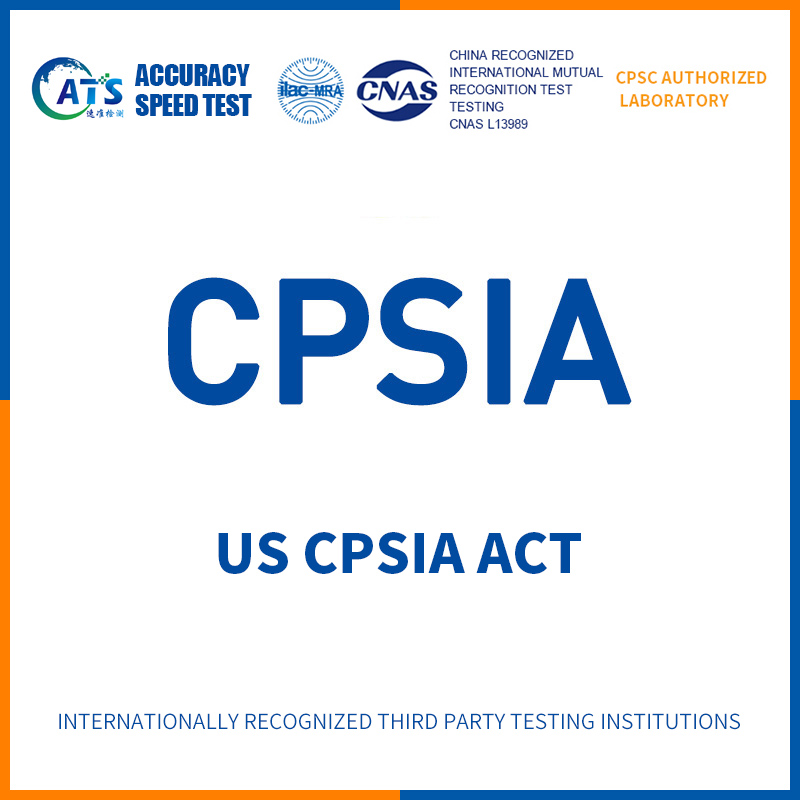Introduction of CPSIA standards
Regulation introduction
CPSC (Consumer Product Safety Committee) is the abbreviation of the US Consumer Product Safety Committee. The US Consumer Product Safety Commission (CPSC) was established in 1972. Its responsibility is to protect the interests of consumers and maintain personal and family safety by reducing the risk of injury and death in consumer products. The main function of the CPSC is to formulate producer self-discipline standards, and to formulate mandatory standards or prohibitions for consumer products that have no standards to follow. Perform inspections on potentially dangerous products, and feedback opinions to consumers through various channels including the media, state, local governments, and individual groups. CPSC is now responsible for the safety monitoring of more than 15,000 consumer products.
CPSIA is the Security Improvement Act signed by US President Bush on August 14, 2008. The Act is the most stringent consumer protection act since the establishment of the Consumer Product Safety Commission (CPSC) in 1972. In addition to stricter requirements for lead content in children's products, the new bill also sets new regulations on the content of harmful substances in toys and child care products. In addition, the bill requires the establishment of a public database on consumer product safety.
Regulation content
The CPSIA regulations are divided into two parts. The first part concerns "Children's Product Safety" and the second part concerns "Consumer Product Safety Commission Reform". The first part involves the following chapters:
Section 101. Children’s product containing lead; Lead paint rule
Section 102. Mandatory third party testing for certain children’s product
Section 103. Tracking labels for children’s products
Section 104. Standards and consumer registration of durable nursery products
Section 105. Labeling requirement for advertising toys and games
Section 106. Mandatory toy safety standards
Section 107. Study of preventable injuries and death in minority children related to consumer products
Section 108. Prohibition on sale of certain products containing specified phthalates
The US Consumer Product Safety Commission (CPSC) final rule (16 CFR 1307) restricting certain phthalates in toys and child care products was published in the Federal Register on October 27, 2017. The final rule take effect on April 25, 2018. According to 16 CFR 1307, the components of toys and child care products shall not exceed 0.1% of phthalates:
DEHP di-(2-ethylhexl) phthalates
DBP dibutyl phthalates
BBP benzyl butyl phthalates
DINP diisononyl phthalates
DPENP di-n-pentyl phthalates (generally call as DnPP)
DHEXP di-n-hexyl phthalates (generally call as DnHP)
DCHP dicyclohexyl phthalates
DIBP diisobutyl phthalates
This rule (b) is based on the recommendations of the Chronic Hazard Advisory Group (CHAP), which reviewed the health effects of phthalates in children’s toys and childcare products. According to the CHAP report, CPSC mostly determined that these five phthalate chemicals are harmful to male reproductive development.
The final rule brings the total number of phthalates restricted to children’s toys and childcare products to 8, and the concentration must not exceed 0.1%.
List of test items
| Item |
Limits |
Item |
Limits |
| Di-(2-ethylhexl) phthalates(DEHP) |
0.1% |
Dibutyl phthalates(DBP) |
0.1% |
| Benzyl butyl phthalates(BBP) |
0.1% |
Diisononyl phthalates(DINP) |
0.1% |
| Di-n-pentyl phthalates (generally call as DnPP) |
0.1% |
Di-n-hexyl phthalates (generally call as DnHP) |
0.1% |
| Dicyclohexyl phthalates(DCHP) |
0.1% |
Diisobutyl phthalates(DIBP) |
0.1% |
| Pb |
90ppm |
Pb |
100ppm |
-
Sample Preparation
Before submitting the products for test, it is best for customers to disassemble and package the submitted products in detail in advance, and indicate the product name and serial number on each package. The weight required for each component test is about 30 grams of solid. The liquid is about 60 ml.
-
No harm to CPSIA regulations
If the product is exported to the United States without CPSIA testing, it will cause incalculable damage to the manufacturer. At that time, your product will be lost in the market. If your product is lucky to enter the other party's market, once it is found, it will be caught in lawsuits or even criminal detention.

-
Speed of phone calls
01

-
Send you samples
02

-
Fill out the application
03

-
Send the quotation
04

-
To complete the payment
05

-
Arrange test
06

-
Finish the report
07

-
Technical support
08
Speed, accuracy and quality policy

 Customer hotline:+86-136 6283 9331
Customer hotline:+86-136 6283 9331 Customer hotline:+86-136 6283 9331
Customer hotline:+86-136 6283 9331












